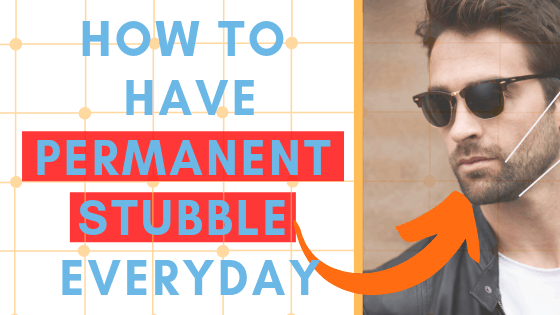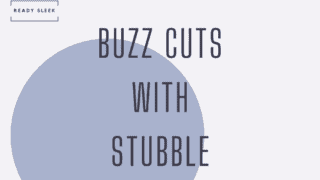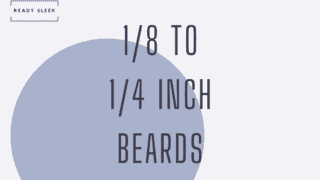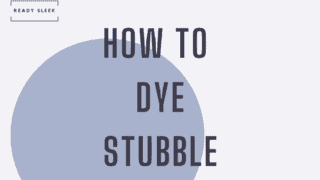To maintain permanent stubble it takes patience, commitment, and skill. A skill we’re going to teach you in detail.
But in a nutshell, how do you maintain stubble all the time?
A permanent stubble style can be achieved by using an electric trimmer to first determine your optimal stubble length and then regularly trimming down to this level. The neckline, cheek line, and more subtle borders are defined using an electric or manual shaver. These borders are dependent on face shape among other factors.
To continue this practice over a long period of time, it does take a certain type of man.
A man who has a vice-like grip on his own sense of style knows exactly what he wants and needs to have it at all times.
Without further ado, let’s dive right into this in-depth tutorial. Afterward, you’ll have a greater sense of consistency in your stubble.
What you’ll need
To maintain a permanent stubble length, you’ll need a strong and somewhat rigid routine. As with any good routine, having a trusted tool kit to go along with it is important.
- A stubble trimmer– An electric beard trimmer is what you’ll use to mow down those whiskers to a nice even length. As you’d expect, it’s the most essential tool you’ll need. The one you choose should have size guards ranging from 0.4mm to 5mm to allow for meticulous control of hair length within our desired “stubble” range. In other words, you’ll need a specialized stubble trimmer.
- An electric shaver or manual razor– This is really just to clean up the neckline and cheek line. It isn’t as essential because, technically if you have a good stubble trimmer with a 0.4mm naked trimmer guard you’ll be able to trim down hairs to a barely noticeable length.
Now that we’ve got our shopping list, let’s talk through how to maintain a permanent stubble beard from start to finish. Ultimately, many claim that it’s the most attractive beard length. Why wouldn’t we want it all the time?

How To Maintain A Permanent Stubble Beard In 5 Easy Steps
Before we start, bear in mind that the objective of this tutorial isn’t to help you choose what style of stubble to go to. It’s to help you find your ideal stubble length and then maintain it for as long as you wish to.
This assumes that you know what style you want but just want to know how to keep it looking the same instead of seeing it go up and down like a yo-yo.
1. Grow it out or trim it down
So this step depends on what you’re starting off with. The goal is to get to 5mm worth of stubble – i.e heavy stubble. From this point, we can trim down incrementally to find your perfect permanent stubble length.
You may already be rocking a longer beard and want to make a smooth transition into stubble territory, this obviously won’t be necessary. By the way, congratulations on making an excellent decision as well.
If you do have a longer beard, just trim it down to approximately 5mm using a clipper or beard trimmer so we have a good starting point to work with.
But if you do indeed have little to no facial hair you will need to grow it out to at least 5mm so we know what we’re at the right starting point.
Put it this way. You can’t trim something that doesn’t exist yet. The amount of time this takes definitely varies from person to person, but 10 days is a pretty safe bet for most.
Also, it’s all approximate. No-one is capable of knowing exactly how long 5mm is unless they’ve got some nifty measuring skills or tools.
2. Start with a long size guard and go slow
Trimming off too much, to begin with, isn’t the end of the world. I mean it’s stubble, right? It won’t take long for it to grow back to your starting point.
But to avoid wasting time and to make sure you hit your sweet spot sooner rather than later, start with a longer size guard eg. between 4 and 5 mm.
Then go down in 0.5mm increments until you find a length you like.
We aren’t going to talk too much about trimming technique in this article. But in general, trimming inwards from the cheeks towards the chin and down from the top border of the mustache to the bottom border is what you want to do.
Trim against the grain for a more uniform outcome.
If you want a nice natural transition, use a slightly shorter size guard (eg 0.5 mm shorter) near the borders. This way your cheek line and neckline won’t be too sharp and will fade neatly into the clean-shaven areas of your face and neck.
These are what we call faded borders and are generally only worth doing if you want to keep longer stubble (4 or 5mm) where the fade would actually be noticeable.
Keep trimming like this, slowly using shorter and shorter size guards until you hit a stubble length you love.
Going down in length slowly like this ensures that you don’t unintentionally overdo it. It also ensures that you get to see what you look like with a wide range of stubble lengths. Your ideal length may be 1.5mm, or it may be 4mm.
If you aren’t exposed to all of these lengths, you may never know.
4. Define the borders
We’ve touched upon this point already and you may have chosen to grade the borders using a slightly shorter size guard when trimming near the neckline and cheek line.
It’s important to note that you do have another option which is to do nothing. Some do prefer natural borders, particularly with the cheek line. It’s quite rare to find someone that doesn’t want to touch their neckline, however.
But a defined cheek line definitely does look cleaner, and neater, and contours the face very nicely. The style is very subjective – your preference may be straight or curved.
A common tactic is to draw a straight line from the bottom corner of the sideburn to the corner of the mouth.
Then just shave everything above this line using either an electric shaver or manual razor. You can dip into your beard a little to give it more of a curve if you’d like.
A more curved cheek line better suits a longer, more angular face. A straighter cheek line better suits a rounder face.
When it comes to the neckline, again there is no right answer. A key objective is to make sure that your beard stays beneath your jawline.
The worst look is when the lower border of the stubble beard ends up above your jaw and on your face when you open your mouth wide. Avoid this.
A common technique is to trim it in a U-shaped curve from behind the earlobes down to a point on your neck approximately two finger-widths above the Adam’s apple. The exact point you
Again, if you’re unsure just shave a lower neckline first and see how it looks. If you want it higher up just gradually raise it. Always go slow when you’re just starting out.
After this is all done you may feel as though the borders are just too sharp. If so, trim the area of your beard nearest the edges again using a size guard 0.5mm shorter than the one you used for the rest of your beard. This will give you that nice, graded effect.
How often will you need to do this to maintain permanent stubble?
No sugar-coating here. Just like any beard style, it requires maintenance. Not as much as a longer beard, but still. With regard to exactly how often, it depends on your rate of growth. It could be every day, or every three days, etc.
Maybe you’ll need to neaten up your borders more often than you’ll need to trim the body of your beard. It’s all very person-specific. It’s safe to say that the more often you do it, the more consistent your look.
If you don’t do this, you’ll notice your hairs becoming less even in length, your borders becoming less defined and your style just getting a little more feral in general.
Once you notice this you’ll be drawn back toward your tool kit and you’ll go at it once more.
It’s the price to pay for phenomenal stubble. Trust me it’s worth it.
Conclusion
Stubble is fantastic for many different reasons. A commonly cited reason is that it is versatile. You can wear it in most contexts and not look out-of-place.
It’s subtle, stylish and masculine.
This tutorial will hopefully help you achieve that and more. Go forth and prosper stubble warriors. Thanks for taking the time to read until the end. Hero.
Ready Sleek founder. Obsessed with casual style and the minimalist approach to building a highly functional wardrobe. Also a fan of classic, vintage hairstyles.







